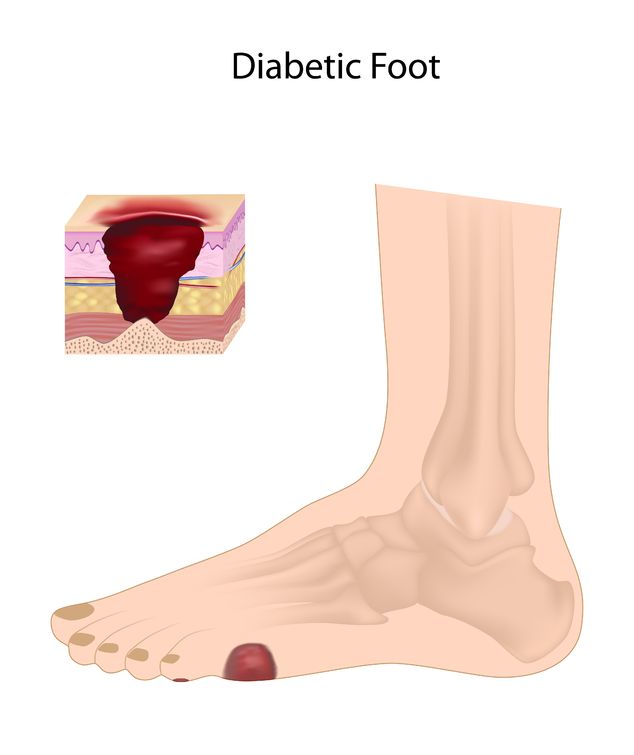Diabetic Foot Care
 Diabetes is a dreadful disease that impacts more than a patient’s blood sugar or dietary choices. Many diabetics end up with diabetic wounds and related complications. Statistics show that every minute, someone in the world loses a lower limb because of diabetes. More often than not, the problem began as a wound or ulcer that would not heal properly on its own.
Diabetes is a dreadful disease that impacts more than a patient’s blood sugar or dietary choices. Many diabetics end up with diabetic wounds and related complications. Statistics show that every minute, someone in the world loses a lower limb because of diabetes. More often than not, the problem began as a wound or ulcer that would not heal properly on its own.
Healing Wounds in Plano & Lewisville
Even the smallest wound or ulcer on the foot can become a severe health issue, especially for diabetics. Together, wounds and diabetes are a dangerous combination.
For a diabetic, there is no such thing as a minor wound. Every wound, no matter how small, can become serious quickly and should be checked out by a wound specialist. Our diabetic wound care specialist at DFW Wound Care Center is experienced in managing and treating diabetic wounds and foot ulcers. Dr. Mobarak always seeks conservative treatment options first.
Causes of Diabetic Wounds and Foot Ulcers
One of the consequences of diabetes is poor circulation and nerve damage. Poor circulation impacts the body’s natural ability to properly heal wounds. Nerve damage impacts the body’s ability to detect pain from the smallest of cuts. Left untreated, even a small cut can become infected. Regular checks of the feet are critical for good health.
Types of Diabetic Wounds
When managing diabetes, every wound should be taken seriously and should be examined immediately by a wound specialist. Always be aware of the skin condition in your foot and lower leg area. There are two primary types of diabetic wounds:
- External Diabetic Wounds
- Internal Diabetic Wounds
External diabetic wounds are dangerous because they usually go unnoticed. Most diabetics have peripheral neuropathy, a condition of damaged or diseased nerves affecting sensation. With peripheral neuropathy, a person may not feel a cut and thus proper treatment can be delayed potentially resulting in further complications.
Internal diabetic wounds are those such as ulcers, ingrown toenails or calluses. These types of wounds can be examined to affect the skin and tissue surrounding the wound increasing the risk of infection. If you have concerns, please see our wound care specialist at DFW Wound Care Center.
Diabetic Wounds Symptoms
If you are a diabetic, or at risk for diabetes, please regularly check your feet. Symptoms may develop slowly but left unchecked can worsen quickly. The common signs of diabetic wounds and ulcers are:
- Numbness or dullness in the lower extremity
- Infection with pus drainage, discharge or odor
- Inflammation
Always take time examining your lower extremities for anything unusual.
Online Diabetic Risk Assessment
We offer a free online diabetic risk assessment that you can take in the privacy of your home. This self-evaluation will only take a few minutes and can help determine your risk for diabetic wounds.
Treatment Options for Diabetic Wounds & Ulcers
In the case of diabetic wounds, the best course for treatment is controlling your diabetes. At DFW Wound Care Center, our goal is to keep your lower extremities healthy. If a wound or ulcer becomes serious in nature, there are a number of treatment options available. Some of the wound treatments we offer are:
- Laser Therapy
- Compression Therapy
- Nerve Conduction Study
- Debridement
- Skin Grafts
- Pressure Off-Loading
- Negative Pressure Therapy
- Lymphedema Therapy
- Edema Control
- Amputation
Schedule a Diabetic Wound Consultation
Our wound specialist is currently accepting new patients. For a proper examination of diabetic wounds and ulcers, call us at 972-424-3505. You can also use our online contact form.
Contact us
Schedule an appointment
with our specialists by contacting us or calling our:
